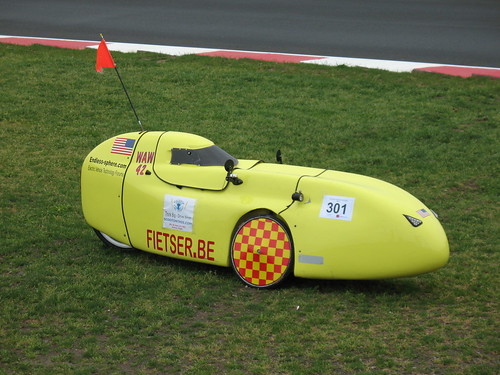recumpence said:
I am not trying to set any records. I am curious more than anything.
I would love, however, to push my own efficiency as far as I possibly can. For me, the best efficiency I have ever achieved without any pedalling what-so-ever, is 13.4WH per mile at 18 miles per hour. I have heard numbers from guys here on the forum, of 15wh per mile at 20 miles per hour (roughly what my bike will do), I have heard 26wh per mile at 26mph. I have heard 9wh per mile at 10mph. etc.
<snip>
Matt
14.12Wh/mi at 31.1 mph avg is what I did last year at the ePower Challenge in Portland, Oregon. I was the second fastest. The bike that was the fastest 24Wh/mi at 35.3mph avg was a Tour Easy with fairing and body sock. I'd love to have a small powerful light weight assist. Matt, I've been following the thread on your system and I would like to put one on my velomobile.
Bill B WAW velomobile running 48v AGM 18Ah with Crystalyte 406 20Ah controller
Distance: 12 laps (23.76 miles)
time: 45 min,
10 sec., Ave 31.1 mph,
Max Speed 34.2 mph,
energy used 335.7 Wh,
Usage per mile 14.12 Wh/
The bike that was the fastest was a Tour Easy with fairing and body sock.
Brent B GRR faired and full tail sock running 36vLi 20Ah with an EcoSpeed drive system
Distance: 15 laps (29.7 miles),
time: 50 min,
30 sec., Avg.: 35.3 mph,
Max Speed: 42 mph,
energy used: 700 Wh,
Usage per mile: 24 Wh
Here are my stats for the three open track sessions and the race:
Sat morning................Sunday morning.....................Sunday afternoon..................Monday race
5 12V AGM 18Ah...........4 12V AGM 18Ah.....................4 12V AGM 18Ah...................4 12V AGM 18Ah
37.7miles...................19.5 miles............................21.3 miles..........................23.4miles
40.4 mph/max.............33.7 mph/max.......................32.9 mph/max....................34.2 mph/max
30.4 mph/avg..............27.3 mph/avg........................29.1 mph/avg.....................31.1 mph/avg
unknown....................288.7Wh--->14.80Wh/mile.........336.4Wh--->15.79Wh/mile......335.7Wh--->14.28Wh/mile
unknown....................20.73Ap................................20.92Ap...........................20.51Ap
unknown....................44.46Vm...............................45.42Vm...........................44.86Vm
unknown....................982.6Wp.............................1006.2Wp...........................969.2Wp
unknown......................6.02Ah...............................6.967Ah............................6.951Ah
unknown....................50.3V at end of run..................unknown............................50.5V at end of run


